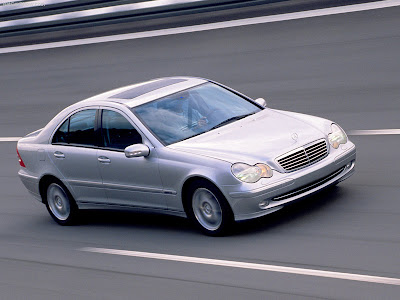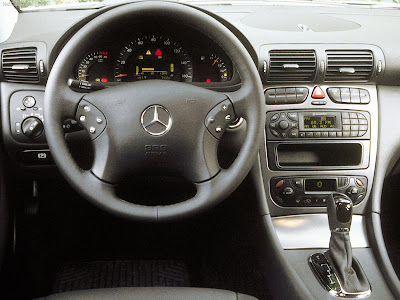








Mercedes-Benz C-Class W203
The second generation C-Class was introduced in 2000, with an even sportier look than the previous generations, with a steeper frontend and shorter rearend. The sedan debuted with a range of straight-four and V6 petrol engines and straight-four and straight-five Diesels. The V6s were versions of the previous model with increased displacement, to 2.6 L and 3.2 L, this one with 218 PS (160 kW/215 hp). The Diesels now featured common rail direct injection and variable geometry turbochargers. Six-speed manual gearboxes were now standard for nearly the entire range (except the C 320 and C 270 CDI). For the first time, the number designations were no longer equivalent to the engine displacement, more specifically in the C 180 (2.0 L), C 240 (2.6 L) and C 200 CDI (2.2 L).
In 2001, Mercedes increased the range, with the introduction of the new T-Modell (station wagon) and Sportcoupé bodyworks. The Sportcoupé was actually a three-door hatchback made to counter the BMW Compact, but like its competitor, it proved unpopular with the younger buyers it was targeted towards, due to high prices compared to the lower entry-level models it was competing against, a cramped cabin, and handling problems when compared to the sedan. It was removed from the US lineup in 2005 and is unlikely to be replaced for the third generation C-Class. A new family of supercharged four cylinder engines, dubbed M271, also debuted. All of them used the same 1.8 L engine, with different designations according to horsepower levels, including a version powered by natural gas. The 193 PS (142 kW/190 hp) C 230K was initially available only in the Sportcoupé. 4MATIC four wheel drive versions were also offered for the C 240 and C 320.
After the success of the AMG models in the previous generation, Mercedes-Benz attempted to increase sales by introducing two different AMG versions in the new model, also in 2001. The C 32 AMG scaled back down to a 3.2 L engine, to match the E46 M3 displacement, but it required a Roots supercharger to reach 354 PS (260 kW/349 hp) at 6100 rpm and 450 Nm (332&ft.lbf) at 4400 rpm. Like its predecessors, it used a five-speed automatic. The second version was C 30 CDI AMG, using a 3.0 L five-cylinder engine, capable of 231 PS (170 kW/228 hp) at 3800 rpm and 540 Nm (398 ft.lbf) at 2000 rpm. Both were available in all three body styles, but the Diesel model did not reach sales expectations and was retired in 2004, as well as the C 32 AMG Sportcoupé.
The C-Class was refreshed in early 2004. In this year, the interior styling was changed in all three body styles. Different taillights were added to the Sportcoupé and several all-new M272 and OM642 V6 engines were introduced later in the year. These were available in both petrol and Diesel configuration, ranging between 2.5 L and 3.5 L, and the three-valve twin spark design was replaced by the more standard four-valve design, now with variable valve timing. The C 350 could now reach 272 PS (200 kW/268 hp), while the C 320 CDI was good for 224 PS (165 kW/221 hp). In addition, these engines also received the new seven-speed 7G-TRONIC semi-automatic gearbox as optional, the Diesel four cylinder's power was slightly increased, and a more economic naturally-aspirated 1.8 L (C 160) was added to the Sportcoupé lineup.
The C 32 AMG was also replaced, giving way to a new 5.5 L naturally-aspirated V8-powered C 55 AMG. This was an evolution of the V8 engine found in the previous E-Class, with power raised to 367 PS (270 kW/362 hp) at 5750 rpm and torque climbing to 510 Nm (376 ft.lbf) at 4000 rpm. Unlike the less-powerful V6s and V8s in the rest of the Mercedes-Benz lineup, it continues to use Speedshift five-speed automatic. Maximum speed is still limited to 250 km/h (155 mph), but the car can now reach 100 km/h (62 mph) in a claimed 5.2 seconds.
The C-Class is arguably one of the most popular automobiles in its class in many of the European markets. The second generation was for a long time after its release the second most popular new car in the German market, right after the Volkswagen Golf, and in 2002 it achieved success in the field of safety by scoring the maximum five stars in a EuroNCAP crash test. In the United States, the C-Class automobiles are the least expensive of the Mercedes-Benz lineup.Mercedes-Benz C-Class W203
The second generation C-Class was introduced in 2000, with an even sportier look than the previous generations, with a steeper frontend and shorter rearend. The sedan debuted with a range of straight-four and V6 petrol engines and straight-four and straight-five Diesels. The V6s were versions of the previous model with increased displacement, to 2.6 L and 3.2 L, this one with 218 PS (160 kW/215 hp). The Diesels now featured common rail direct injection and variable geometry turbochargers. Six-speed manual gearboxes were now standard for nearly the entire range (except the C 320 and C 270 CDI). For the first time, the number designations were no longer equivalent to the engine displacement, more specifically in the C 180 (2.0 L), C 240 (2.6 L) and C 200 CDI (2.2 L).
In 2001, Mercedes increased the range, with the introduction of the new T-Modell (station wagon) and Sportcoupé bodyworks. The Sportcoupé was actually a three-door hatchback made to counter the BMW Compact, but like its competitor, it proved unpopular with the younger buyers it was targeted towards, due to high prices compared to the lower entry-level models it was competing against, a cramped cabin, and handling problems when compared to the sedan. It was removed from the US lineup in 2005 and is unlikely to be replaced for the third generation C-Class. A new family of supercharged four cylinder engines, dubbed M271, also debuted. All of them used the same 1.8 L engine, with different designations according to horsepower levels, including a version powered by natural gas. The 193 PS (142 kW/190 hp) C 230K was initially available only in the Sportcoupé. 4MATIC four wheel drive versions were also offered for the C 240 and C 320.
After the success of the AMG models in the previous generation, Mercedes-Benz attempted to increase sales by introducing two different AMG versions in the new model, also in 2001. The C 32 AMG scaled back down to a 3.2 L engine, to match the E46 M3 displacement, but it required a Roots supercharger to reach 354 PS (260 kW/349 hp) at 6100 rpm and 450 Nm (332&ft.lbf) at 4400 rpm. Like its predecessors, it used a five-speed automatic. The second version was C 30 CDI AMG, using a 3.0 L five-cylinder engine, capable of 231 PS (170 kW/228 hp) at 3800 rpm and 540 Nm (398 ft.lbf) at 2000 rpm. Both were available in all three body styles, but the Diesel model did not reach sales expectations and was retired in 2004, as well as the C 32 AMG Sportcoupé.
The C-Class was refreshed in early 2004. In this year, the interior styling was changed in all three body styles. Different taillights were added to the Sportcoupé and several all-new M272 and OM642 V6 engines were introduced later in the year. These were available in both petrol and Diesel configuration, ranging between 2.5 L and 3.5 L, and the three-valve twin spark design was replaced by the more standard four-valve design, now with variable valve timing. The C 350 could now reach 272 PS (200 kW/268 hp), while the C 320 CDI was good for 224 PS (165 kW/221 hp). In addition, these engines also received the new seven-speed 7G-TRONIC semi-automatic gearbox as optional, the Diesel four cylinder's power was slightly increased, and a more economic naturally-aspirated 1.8 L (C 160) was added to the Sportcoupé lineup.
The C 32 AMG was also replaced, giving way to a new 5.5 L naturally-aspirated V8-powered C 55 AMG. This was an evolution of the V8 engine found in the previous E-Class, with power raised to 367 PS (270 kW/362 hp) at 5750 rpm and torque climbing to 510 Nm (376 ft.lbf) at 4000 rpm. Unlike the less-powerful V6s and V8s in the rest of the Mercedes-Benz lineup, it continues to use Speedshift five-speed automatic. Maximum speed is still limited to 250 km/h (155 mph), but the car can now reach 100 km/h (62 mph) in a claimed 5.2 seconds.
The C-Class is arguably one of the most popular automobiles in its class in many of the European markets. The second generation was for a long time after its release the second most popular new car in the German market, right after the Volkswagen Golf, and in 2002 it achieved success in the field of safety by scoring the maximum five stars in a EuroNCAP crash test. In the United States, the C-Class automobiles are the least expensive of the Mercedes-Benz lineup.
No comments:
Post a Comment